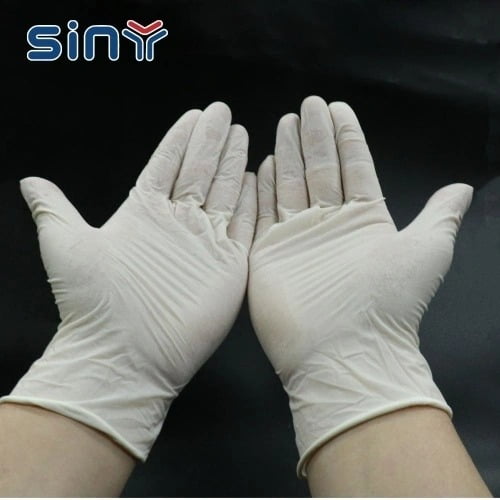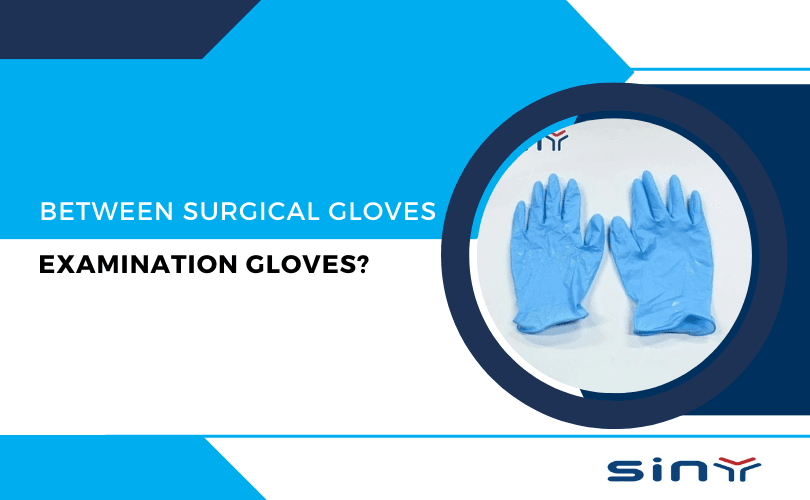Gloves are crucial in maintaining hygiene and safety in the medical field. Whether during a life-saving surgery or a routine physical examination, the type of glove used can significantly impact performance, safety, and overall results. Understanding the difference between surgical and examination gloves is essential for medical gloves professional and industries where hygiene and protection are paramount.
There are some differences between surgical gloves and examination gloves in terms of use, material, performance, specifications, etc.
Table of Contents
Introduction
What Is a Surgical Glove?
A surgical glove is a specially designed glove used by healthcare professionals during surgical procedures. Its primary purpose is to maintain a sterile environment, ensuring the safety of both the patient and the surgical team. Surgical gloves create a protective barrier to:
- Prevent the transmission of infectious agents from the patient to the surgical team.
- Protect the patient from potential contamination by microorganisms on the surgeon’s hands.

What Is an Examination Glove?
An examination gloves serves as a disposable glove that healthcare professionals use during non-surgical medical procedures, including patient examinations, diagnostics, and laboratory work. These gloves act as a barrier to cross-contamination between healthcare providers and patients, ensuring protection from transmitting pathogens and harmful substances.
Purpose and Usage
Surgical gloves
Mainly used for surgical operations, providing a protective barrier for surgical personnel to prevent the patient’s blood, body fluids and other infectious substances from contacting the hands of the surgical personnel during the operation and also to prevent the bacteria and other microorganisms on the hands of the surgical personnel from contaminating the surgical incision, reducing the risk of surgical infection, and ensuring the sterile environment of the operation and the safety of the patient.
Examination gloves
Mainly used for medical examinations, diagnosis, treatment and other operations, such as physical examinations, oral examinations, gynaecological examinations, laboratory examinations, etc., to prevent cross-infection between doctors and patients and protect patients and medical staff from possible pathogen transmission.
Material
Usually made of natural rubber latex, with good elasticity, flexibility and fit, it can provide precise hand operation feeling so that surgical personnel can flexibly operate various surgical instruments during the operation.
Many materials include natural rubber latex, nitrile rubber, polyvinyl chloride (PVC), etc. Latex examination gloves offer good elasticity and comfort, but some individuals may experience latex allergies. Nitrile rubber examination gloves provide excellent chemical resistance and puncture resistance, eliminating the risk of latex allergy, which has led to their increasing popularity. PVC examination gloves are relatively inexpensive and offer a degree of flexibility and waterproof properties.
Performance requirements
Surgical gloves
The sterility requirements are incredibly high, and they must undergo strict sterilization treatment, such as ethylene oxide sterilization, to ensure a sterile environment during surgery.
In addition, surgical gloves must have high strength and tear resistance to prevent surgical contamination caused by glove rupture during surgery.
At the same time, the fit requirements of surgical gloves are also very high. They must be able to fit tightly to the hands of the surgeon, not hinder the flexible movement of the fingers, and enable the surgeon to perform various delicate operations accurately.
Examination gloves
Although they also require a certain degree of sterility, the sterility requirements are relatively low, and they are generally disinfection-grade or non-sterile products. The strength and tear resistance requirements of examination gloves are relatively low, but they need good barrier properties to prevent the spread of pathogens effectively.
At the same time, the comfort of examination gloves is also an important consideration, as it should make medical staff feel comfortable during long-term examination operations.
Specifications and sizes
Surgical gloves: The specifications and sizes are relatively strict. Surgeons typically select glove models based on the size of their hands, choosing from options like No. 5.5, No. 6, No. 6.5, No. 7, No. 7.5, and No. 8. This careful selection ensures that the gloves fit tightly and do not interfere with the surgical operation.
Examination gloves: The specifications and sizes are relatively loose, typically divided into several standard models—large, medium, and small—to accommodate the hand sizes of various medical staff. However, the fit requirements are more relaxed compared to surgical gloves.
Colour
Surgical gloves: Usually white or light blue, these two colours help surgeons observe the surgical site and the surface of the gloves more clearly during the operation and detect possible contamination or glove damage in time.
Examination gloves: The colors are more diverse. In addition to white and light blue, there are also pink, purple, green and other colours to choose from. Examination gloves of different colours can distinguish different inspection items or departments, which is convenient for management and use.
Key Differences at a Glance
| Feature | Surgical Gloves | Examination Gloves |
|---|---|---|
| Primary Use | Surgical operations | Medical exams, diagnostics |
| Material | Latex, nitrile, polyisoprene | Latex, nitrile, PVC |
| Sterility | Strictly sterile | Often non-sterile |
| Fit | Precision-fit for specific sizes | General sizes (S, M, L) |
| Strength | High strength, tear-resistant | Moderate strength |
| Colors | White or light blue | Diverse colors |
Conclusion
In summary, surgical and examination gloves serve as essential protective barriers in healthcare, but they are designed for different purposes and meet distinct standards. Surgical gloves offer higher quality, precision, and protection for surgical procedures, while examination gloves provide versatility and affordability for general medical tasks. Understanding medical gloves distinctions is crucial for healthcare professionals to ensure they select the appropriate gloves for their specific needs.
FAQs Surgical Gloves and Examination Gloves
What are surgical gloves used for?
Surgical gloves are used in surgical procedures to ensure a sterile environment. They prevent transferring bacteria, viruses, and other contaminants between the surgeon and the patient, reducing the risk of infection.
What are examination gloves used for?
Healthcare providers use examination gloves during medical examinations, diagnostic tests, and minor procedures to protect themselves and patients from contamination and the spread of pathogens.
Are surgical gloves and examination gloves sterile?
Surgical gloves are always sterile to meet the high standards required for surgical procedures. Examination gloves can be sterile or non-sterile, depending on the intended use.
What materials are surgical gloves made of?
Surgical gloves are typically made from natural latex, synthetic nitrile rubber, or polyisoprene. These materials provide high elasticity, durability, and precision for delicate surgical tasks.
What materials are examination gloves made of?
Examination gloves can be made from latex, nitrile, or polyvinyl chloride (PVC). Latex offers comfort and flexibility, nitrile provides chemical and puncture resistance, and PVC is economical for general use.
Why are nitrile gloves a popular choice for examination gloves?
Nitrile gloves are popular because they are latex-free, reducing the risk of allergic reactions. They also offer excellent chemical resistance, durability, and puncture protection.
Can surgical gloves be reused?
No, surgical gloves are single-use items. Reusing them could compromise sterility and increase the risk of infection.
How do you choose the right size for gloves?
Surgical gloves are available in precise sizes (e.g., 6, 6.5, 7) to ensure a perfect fit. Users should select a size of examination gloves (small, medium, large) that feels snug but allows for free movement.



























































